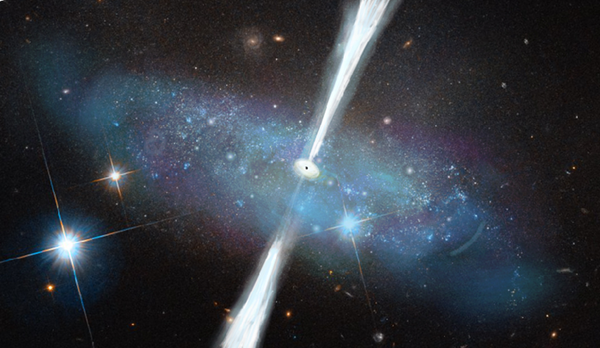Supermassive black holes millions or billions of times the mass of the Sun lie at the centers of large galaxies like the Milky Way. But astronomers don’t know how they got there.
They do know, however, that galaxies grow by merging. One theory for how such massive black holes form is that the early universe was rife with dwarf galaxies with smaller, so-called intermediate-mass black holes (IMBHs; hundreds to thousands of solar masses) at their centers. Over time, these dwarfs merged or were swallowed by larger galaxies, their cores combining each time to build up a monster in the middle of the final galaxy.
But until recently, only a tiny fraction of dwarf galaxies were actually known to host massive black holes in their centers. This is because classic black hole-hunting techniques, which look for the bright accretion disks around actively feeding black holes (called active galactic nuclei or AGN), were developed with larger galaxies and their black holes in mind, and aren’t suitable for finding black holes in dwarf galaxies. But now, a recent study published in The Astrophysical Journal and led by scientists at the University of North Carolina at Chapel Hill has discovered a previously “hidden” population of black holes with the help of an improved classification scheme.
A new perspective
Whilst looking for black holes using traditional techniques back in 2014, Sheila Kannappan, along with undergraduate students Ashley Bittner and Carlynn Ferguson, identified a particular type of dwarf galaxy for which three traditional diagnostic tests for finding black holes give different answers. Two of the tests say there is an AGN, while the third says only star formation is present.
“Dwarf galaxies are more primordial in their composition and have tons of star formation going on,” Kannappan says. “And the emission, or glow, from star formation can compete with emission from the AGN, making it hard to tell whether an AGN is really there. This is why the tests designed for giant galaxies don’t work as well on them,” she explains: “The particular test that fails to recognize an AGN is present is sensitive to the abundance of the higher elements we call ‘metals,’ which dwarfs don’t have as much of.”
So, Kannappan’s group developed a test that took these characteristics into account. Instead of throwing away galaxies with conflicting test results, they identified them as a new category. Then team member Chris Richardson of Elon University followed up with computer simulations, which showed agreement between galaxies in the new category and theoretical predictions for the output of a model dwarf galaxy with an IMBH.
Hidden no longer
Graduate student Mugdha Polimera — lead author of the study — applied the new selection technique to published spectroscopic measurements for galaxies in two surveys: RESOLVE and ECO. What she found surprised everyone.
More than 80 percent of the active black holes detected in dwarf galaxies turned out to be part of this previously hidden population, meaning they would otherwise have been missed.
“We went through a list of all the possible explanations,” Polimera says, to make sure they were really picking up the signals from growing black holes. “Could it be extreme star formation? Could it be some other exotic astrophysics, some kind of diffuse gas? In the end we concluded that what we were seeing was most likely from black holes.”
This study represents nearly a decade of work for Kannappan and her group. If their technique proves reliable, it could provide the first concrete evidence that supermassive black holes are built from mergers of dwarf galaxies with IMBHs.
Romeel Davé of the University of Edinburgh, who was not part of the study, is also cautiously optimistic about this new method and the “treasure trove” of black holes it has uncovered. “Theorists, like myself, are very good at coming up with clever ideas,” Davé says. “But to know if something is right, well, that requires actual data. This study provides the first real constraints for how many black holes in dwarf galaxies might be out there.”










